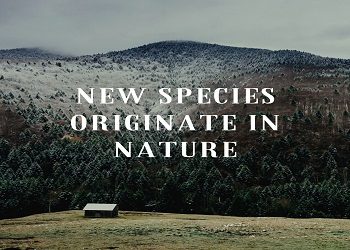New Species Originate In Nature:
Origin of species is also known as speciation. A species is defined as one or more populations of similar organisms which can interbreed among themselves. Species exhibit similarity because they share a common gene pool which is the total number of different kinds of genes (alleles) present in all the individuals of that population. Thus, the individuals of a population adapt themselves to a new environment with the help of their gene pool. But, generally, it is noticed that the populations of a species are many and they live in different geographical regions having different environmental conditions. These populations are said to be adapted to their respective conditions by the process of natural selection and mutations. In doing so, they become different from one another. Even then, these are called one species because their members are capable of interbreeding among themselves. Thus, the two populations differing from one another remain the same species so long they are capable of interbreeding among themselves. The prevention of interbreeding between members of different species is essential for the maintenance of identity of the species. It is an established fact that life arises from pre-existing life. It is also thought that new species are derived from the pre-existing ancestral species. To explain how it happens, consider the origin of a terrestrial species which has a wide range of distribution. Due to the presence of a physical barrier like a high mountain range, a large body of water, desert or glacier, its range of distribution becomes restricted and it becomes impossible to maintain interbreeding between the members of the groups thus separated. Sometimes, the long-distance between populations may act as a reproductive barrier between them. In the initial stages, interbreeding between the individuals of these two populations will be possible if the isolation factor is artificially removed. However, the absence of reproductive contact for a long time will lead to a loss of capacity for interbreeding. In the due course of time, the individuals of these populations undergo physical and physiological changes depending upon their environment, so that they become morphologically different from each other. They would gradually go away from each other in structure and function and ways of living and become so different as to give rise to a new species.
A genetic mechanism called polyploidy may also lead to the formation of new species very quickly. It means the multiplication of basic sets of chromosomes. Example- triploid (3n), tetraploid (4n), pentaploid (5n), hexaploid (6n), etc. The phenomenon of Polyploidy is of universal occurrence in plants but is very rare in animals. So, different varieties of wheat have been obtained by polyploidy. For example– Triticum aestivum (2n = 42) is a hexaploid wheat, which is formed by the polyploidy of Triticum monococcum (2n = 14) and Triticum durum (2n = 28).









Comments (No)